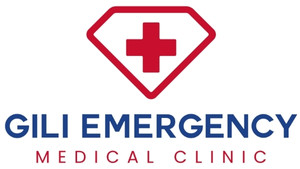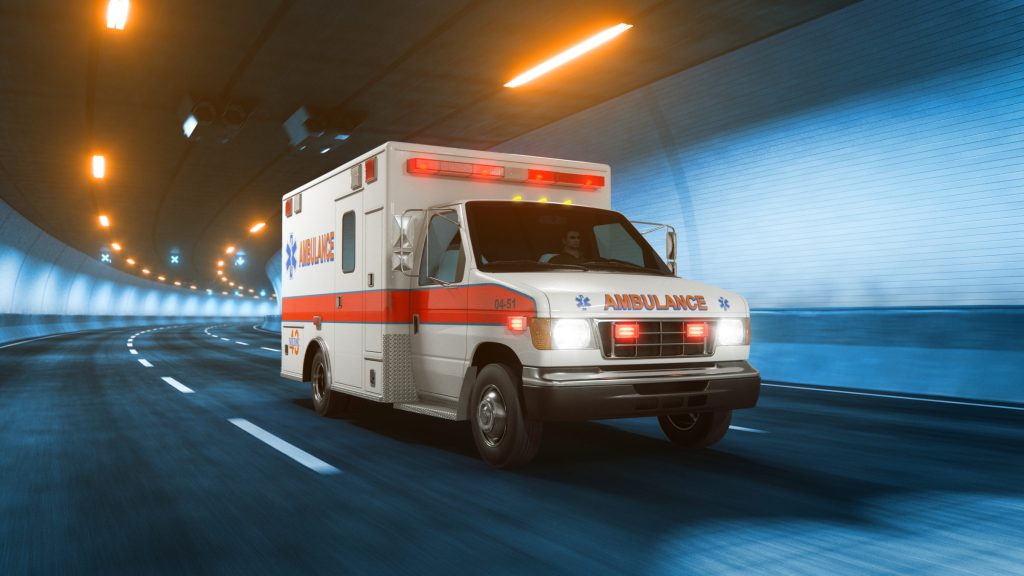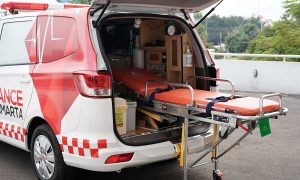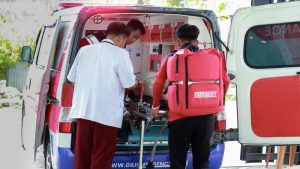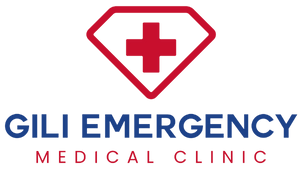You know that dreamy feeling when you’re chilling on Gili Air—bare feet in the sand, drink in hand, music playing softly in the background? Yeah, pure bliss. But here’s a wild thought: what happens if something not so chill suddenly goes down? Like a scooter crash, a bad fall, or a diving accident? That’s when the Gili Air ambulance response time suddenly becomes the most important thing on the island.
And trust me, on a small tropical island with no cars and sandy paths, “fast” means something totally different. So let’s dive into what really happens when someone calls for help on Gili Air, how ambulance Gili, Gili medical service, and Gili clinic keep things moving, and what makes every single minute count.
What Is the Gili Air Ambulance Response Time and Why Does It Matter?
Let’s start simple. Gili Air ambulance response time is basically how long it takes from when you make that emergency call to when help actually arrives. Sounds straightforward, right? But on a tiny island surrounded by ocean and connected only by boats, that “time gap” can feel like forever.
Here’s the deal — when stuff gets real (we’re talkin’ heart attacks, deep cuts, allergic freak-outs, or drowning), every single second counts. The faster the Gili ambulance crew gets to you, the better your shot at bouncing back.
But let’s be real — this ain’t your usual city ambulance vibe. On Gili Air, there are zero cars, no noisy motorbikes, just sandy trails full of bikes, barefoot wanderers, and good vibes all around. Sometimes the Gili Air ambulance response time isn’t about traffic jams — it’s about the tide, the weather, and how fast the crew can cruise through this island paradise on pure island energy.
Challenges That Affect Ambulance Speed on Gili Air
1. Infrastructure and Narrow Roads
Gili Air’s beauty is also its biggest challenge. The island has no asphalt roads—only sandy tracks winding through coconut trees and cafes. Standard ambulances? Forget it. Ambulance Gili uses smaller vehicles, carts, or electric buggies to reach patients. And when the paths are too tight or crowded, paramedics might have to walk or carry stretchers by hand.
Imagine it: a medic jogging barefoot through sand, with the ocean breeze and tourists staring—it’s heroic, but not exactly efficient.
2. Dependence on Sea Transport
If a patient needs more advanced care—say, surgery or intensive treatment—they have to be transferred to Lombok or Bali. And that’s where things can get tricky. The Gili Air ambulance response time includes not just land transport, but also the wait for a boat.
When the weather’s calm, a fast boat can cross to Lombok in about 15–20 minutes. But when the sea gets rough? That same trip might take double—or worse, be delayed entirely.
3. Limited Facilities in Gili Medical Service and Gili Clinic
The Gili clinic and Gili medical service are incredible for an island this size. They can handle first aid, stitches, dehydration, minor infections—you name it. But they’re not hospitals. So if something major happens, the patient has to be stabilized, then evacuated off-island. That adds layers of coordination, which—yep—adds minutes to the Gili Air ambulance response time.
4. Communication and Coordination Barriers
Signal drops are part of Gili life. One minute you’re streaming music, the next minute, poof. And in emergencies, that’s a huge deal. If the person calling can’t share their location clearly or the signal cuts off mid-call, dispatchers at Gili medical service lose precious time figuring out where to go.
Realistic Ambulance Response Times on Gili Air
Alright, let’s talk real numbers.
On average:
- For minor incidents (cuts, heatstroke, fevers): 10–20 minutes.
- For serious emergencies involving boats or transfers: 30–60 minutes, depending on the tide and coordination.
A local once told me about a tourist who slipped on coral near the harbor. Luckily, the ambulance Gili arrived in about 15 minutes, and Gili clinic patched her up quickly. But another story—someone fainted during a sunset yoga class far from the main road. The medic had to come on foot for part of the way, and it took almost 40 minutes total.
So yeah, Gili Air ambulance response time varies wildly—but even at its slowest, it’s still a lifeline.
How Gili Medical Service and Gili Clinic Improve Response Time
Gili Clinic: The First Stop for Emergency Care
The Gili clinic is like the island’s heartbeat. This is where most of the drama kicks off. Dehydration, food poisoning, nasty cuts — you name it, they’ve seen it. The clinic crew’s got one mission: get you steady, fast. They’ll patch you up, stop the bleeding, kill the pain, and figure out if you’re good to chill or need to bounce for evacuation.
They also know the island inside out. That local knowledge helps them guide ambulance Gili teams faster than GPS ever could.
Gili Medical Service: The Coordination Backbone
If Gili clinic is the heart, then Gili medical service is the brain. They take the emergency calls, decide which team to send, and coordinate land and sea transport.
The faster they communicate, the faster everything moves. When dispatchers and paramedics work in sync, the Gili Air ambulance response time drops dramatically. That’s why having trained staff and clear radio contact is everything here.
Strategies to Improve Ambulance Response on Gili Air
You can’t control the weather—but you can control the system. Here’s how Gili Air is leveling up its emergency game:
- Strategic Ambulance Stations
Placing ambulance Gili units in key areas (harbor, main village, tourist zones) helps reach emergencies faster. - 24/7 Paramedic Readiness
Having paramedics on standby at Gili clinic and Gili medical service around the clock keeps response times tight—even at 3 a.m. - Dedicated Medical Boats
Some private operators are now offering fast-boat transfers for medical use only. When minutes matter, that’s huge. - Digital Coordination Tools
GPS-based apps for emergency calls, integrated directly with Gili medical service, could completely change the game. - Regular Training and Simulations
Practice saves lives. The more often responders simulate real emergencies, the smoother the real thing goes. - Community Involvement
Locals and resorts often help guide ambulances, clear paths, or even assist with transport. The island works best when everyone’s part of the team.
What You Can Do as a Visitor or Resident
Even if you’re just visiting, you can make a difference. Here’s how to help when emergencies happen:
- Save the Gili medical service number on your phone.
- Share your exact location—not “near the beach,” but specific landmarks or GPS pins.
- Stay calm. Breathe. Clear the way for responders.
- Don’t crowd the scene. It slows things down.
- Help guide the ambulance. Wave them in or light up the path at night.
You’d be surprised how much faster help arrives when people stay organized instead of panicking.
A Tale of Two Emergencies: Why Timing Is Everything
Here’s a story you won’t forget.
A traveler once cut her foot on glass during a beach party. Locals called Gili medical service, and within 20 minutes, ambulance Gili was there. The Gili clinic patched her up fast, and she was back watching the sunrise the next day.
But another time, a surfer was thrown off his board in bad weather. The waves were brutal, and the medical boat couldn’t leave right away. The Gili Air ambulance response time stretched to over 90 minutes, including sea transfer. He made it—but just barely.
Same team, same island, different timing. That’s the power—and pressure—of response time.
Future Goals for Faster Ambulance Response
Let’s talk dreams.
The goal is to make Gili Air ambulance response time faster, smarter, and more reliable. Imagine:
- Under 10 minutes for on-island emergencies.
- Under 30 minutes for those needing sea transfers.
- Drones delivering first-aid kits and medicine to remote areas.
- High-speed medical boats always ready to go.
It sounds futuristic, but honestly, with Gili Air’s community spirit, it’s not impossible.
Building a Faster, Safer Gili Air
End of the day, the Gili Air ambulance response time ain’t just about stats — it’s about people. It’s about that tourist who gets help just in time, the local fam who sleeps easier knowing there’s backup, and the medical crew who never quits, even when the waves are wild.
The crew — ambulance Gili, Gili medical service, and Gili clinic — totally shows that even a small island can handle big drama with heart, hustle, and a ton of island spirit.
So next time you’re walkin’ barefoot under those dreamy Gili stars, remember — behind all that chill, sunset-soaked vibe, there’s a badass team ready to jump into action the moment things get real.
